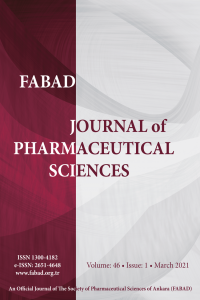Chandan HIRENALLURE MAHESHWARAPPA, Krishna KAMSAGARA LINGANNA, Prashanth Kumar BOMMENAHALLI REVANAPPA, Seema MEHDI, Shreyas AYACHIT, Suman SUMAN, Nandini HITTANAHALLI SHIVAKUMAR, Sneha DESAI, Swerna ESWARAN
Yeni Glitazonların, STZ ile İndüklenmiş Hiperglisemik Sıçan Modelinde Hiperglisemiyi Tersine Çevirmesi
Diabetes mellitus, insülin salgılanmasının veya insüline duyarlılığın azalması ile karakterize edilen en yaygın kronik metabolik hastalıktır. Aynı zamanda plazmada glukoz seviyelerinin yetersiz kontrolü hastalığıdır. Bu çalışmada, yeni glitazonların, STZ ile indüklenmiş hiperglisemik sıçanlardaki hipoglisemik aktiviteleri değerlendirildi. In vivo çalışmalardan önce, 32 adet yeni glitazonun moleküler yerleştirme çalışması gerçekleştirildi. Moleküler yerleştirme çalışması, C5 ve C22 bileşiklerinin hedef protein 3CS8 ile daha iyi bağlandığını
gösterdi. Akut toksisite çalışmaları, OECD kılavuzu 425 kullanılarak dişi farelerde yapıldı. Bileşikler, sıçanlarda test edildiğinde 300 mg/ kg’da mortalite göstermedi. Bu nedenle in vivo çalışmalar için bu doz seçildi. C5 ve C22 bileşiklerinin hipoglisemik aktiviteleri, 10 ve 20 mg / kg konsantrasyonda, STZ ile indüklenmiş hiperglisemik sıçanlarda değerlendirildi. Her iki dozda da (10 mg hem de 20 mg/ kg) bileşik C5, C22’den daha iyi bir aktivite gösterdi, C22 daha yüksek dozda daha iyi bir aktivite sergiledi. Aktivite 0, 7, 14 ve 21. gününde davranışsal parametreler, plazma kan glukoz seviyesi ile değerlendirildi. Çalışma süresi üç hafta olup, 21. günde, hayvanlar sakrifiye edildi ve biyokimyasal analizler yapıldı. Bileşik C5, C22 ile
karşılaştırıldığında önemli bir aktivite gösterdi. Yeni glitazonların hipoglisemik aktivitesini ispatlamak için daha fazla araştırma gerekmektedir.
Anahtar Kelimeler:
Moleküler yerleştirme, PPARγ, glitazonlar, diyabet, 3CS8, lipit profili.
Novel Glitazones Reverses Hyperglycemia In STZ Induced Hyperglycaemic Rat Model
Diabetes mellitus is the most common chronic metabolic disorder characterized by reduced secretion of insulin or sensitivity to the insulin. It is also a disease of inadequate control of glucose levels in the blood plasma. The present study was formulated to assess the novel glitazones for hypoglycaemic activity in STZ induced rat model. Before in-vivo studies, thirty-two virtual compounds of novel glitazones were subjected to the molecular docking study. The docking study showed that, the compounds C5 and C22 showed the better
binding activity with the target protein 3CS8. The acute toxicity studies were done on female rats using OECD guideline 425. No mortality observed at 300 mg/kg per kg body weight and based on this result, the dose for in-vivo studies was chosen. The compounds C5 and C22 were evaluated for the hypoglycaemic activity at 10 and 20 mg/kg body weight in STZ induced hyperglycaemic rats. The compound C5 at both the dose (10 mg and 20 mg/kg) showed the better activity than C22, where as C22 exhibited better activity at higher dose when tested. The activity was assessed by behavioural and biochemical parameters, on 0th ,7 th, 14 th and 21st day. The study duration was three weeks, on 21st day, the animals were sacrificed and biochemical estimations were done. The compound C5 showed significant activity when compared with C22. The current findings gives a lead for further research to prove the hypoglycaemic activity of novel glitazones at molecular level by employing some more research models.
Keywords:
Molecular docking, PPARγ, glitazones, diabetes, 3CS8, lipid profile.,
___
- Davis, S. (2012). Oral hypoglycaemic drugs for the treatment of type 2 diabetes mellitus. SA Pharmaceutical Journal, 79(3), 22-26. DOI: 10.10520/EJC119715
- B. M. (2014). Hypoglycaemia in diabetes mellitus: epidemiology and clinical implications. Nature Reviews Endocrinology, 10(12), 711-722. DOI: 10.1038/nrendo.2014.170
- Graham, M. L., Janecek, J. L., Kittredge, J. A., Hering, B. J., Schuurman, H. J. (2011). The streptozotocin-induced diabetic nude mouse model: differences between animals from different sources. Comparative Medicine, 61(4), 356-360. GraphPad Software LLC. (2020). GraphPad Prism 8 Statistics Guide - Welch and Brown-Forsythe ANOVA. Retrieved July 24, 2021, from https://www.graphpad.com/guides/prism/latest/userguide/using_analyzing_data.htm
- Lionta, E., Spyrou, G. K., Vassilatis, D., Cournia, Z. (2014). Structure-based virtual screening for drug discovery: principles, applications and recent advances. Current Topics in Medicinal Chemistry, 14(16), 1923-1938. DOI: 10.2174/1568026614666140929124445
- Lohning, A.E., M Levonis, S., Williams-Noonan, B., S Schweiker, S. (2017). A practical guide to molecular docking and homology modelling for medicinal chemists. Current Topics in Medicinal Chemistry, 17(18), 2023-2040. DOI: 10.2174/1568026617666170130110827
- Mal, S., Dwivedi, A. R., Kumar, V., Kumar, N.,Kumar, B., Kumar, V. (2021). Role of Peroxisome Proliferator-Activated Receptor Gamma (PPARγ) in Different Disease States: Recent Updates. Current Medicinal Chemistry, 28(16), 3193-3215. DOI: 10.2174/0929867327666200716113136.
- Meng, X. Y., Zhang, H. X., Mezei, M., Cui, M. (2011). Molecular docking: a powerful approach for structure-based drug discovery. Current Computer-aided Drug Design, 7(2), 146-157. DOI: 10.2174/157340911795677602
- Mohammed, F. Z., Gurigis, A. A., Abdel-Mageed, W. S., Nassr, A. (2018). Improvement of Insulin Sensitivity and Maintenance of Glucose Homeostasis in Insulin-sensitive Tissues via PPAR-γ and Through Activation of PI3K/p-Akt Signaling Pathway by Resveratrol in Type 2 Diabetic Rats. Journal of Molecular Immunology, 3(119), 2.DOI: 10.21608/BLJ.2016.48169
- Mukhtar, Y., Galalain, A., Yunusa, U. (2020). A modern overvİew on diabetes mellitus: a chronic endocrine disorder. European Journal of Biology, 5(2), 1-14. DOI: 10.47672/ejb.409
- OECD (Organisation for Economic Cooperation and Development). (2008). Test No. 425: Acute Oral Toxicity: Up-and-Down Procedure. Test,(October), 1–21.
- Yoshino, J., Baur, J. A., Imai, S. I. (2018). NAD+ intermediates: the biology and therapeutic potential of NMN and NR. Cell Metabolism, 27(3),513-528. DOI: 10.1016/j.cmet.2017.11.002
- Zheng, Y., Ley, S. H., Hu, F. B. (2018). Global aetiology and epidemiology of type 2 diabetes mellitus and its complications. Nature Reviews Endocrinology, 14(2), 88-98. DOI: 10.1038/nrendo.2017.151
- ISSN: 1300-4182
- Yayın Aralığı: Yılda 3 Sayı
- Başlangıç: 2005
- Yayıncı: FABAD Ankara Eczacılık Bilimleri Derneği
Sayıdaki Diğer Makaleler
Rijawan Rajjak PATHAN, Aquil-ur-rahim SIDDIQUI
Bülent SAMANCI, Fatma GÜLGÜN YENER, İsmail Tuncer DEĞİM
Chandan HIRENALLURE MAHESHWARAPPA, Krishna KAMSAGARA LINGANNA, Prashanth Kumar BOMMENAHALLI REVANAPPA, Seema MEHDI, Shreyas AYACHIT, Suman SUMAN, Nandini HITTANAHALLI SHIVAKUMAR, Sneha DESAI, Swerna ESWARAN
Seda İPEK, İrem İYİGÜNDOĞDU, Aylin ÜSTÜNDAĞ, Yalçın DUYDU
Astrosit-Nöron Metabolik Orkestrasının Şefi
Antipsoriatik Tedavide Son Gelişmeler: Bir Güncelleme
Shaik SHAFIULLA, Suneela DHANESHWAR
Sadanand YEWALE, Zeba FARASH, Shrikant KULKARNI, Shital PALGHADMAL, Neelam ATHAWALE, Laxman SAWANT, Shrinivas BHOPE, Sriram PADMANABHAN
